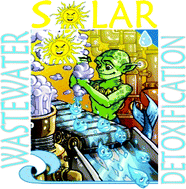A photocatalytic study of a coloured effluent from a wastewater treatment plant was carried out in a pilot plant using compound parabolic collectors (CPC) in order to find out the best conditions for colour removal, since the discharge limit for this parameter is not achieved after conventional wastewater treatment. The interaction between ultraviolet natural radiation and TiO2 strongly enhanced the colour degradation rate. Different TiO2 concentrations were tested and the optimum concentration achieved was 200 mg L−1. The use of peroxydisulfate (S2O82−) as an additional electron scavenger gave a noticeable effect on colour and dissolved organic carbon (DOC) removal due to the formation of additional powerful oxidant species (OH˙ and SO4˙−). However, hydrogen peroxide (H2O2) as additional oxidant was more efficient on colour degradation than S2O82−. The amount of energy necessary for the same colour removal (C/C0 < 0.1) was 6, 14 and 80 kJUV L−1, respectively, for the following systems using sunlight: 200 mg L−1 TiO2 + 5 mM H2O2, 200 mg L−1 TiO2 + 2 mM S2O82− and 200 mg L−1 TiO2. The first-order kinetic constants (0.487, 0.207 and 0.053 L kJ−1) and initial degradation rates (32.1, 10.0 and 2.2 mg kJ−1) showed the same behaviour.

You have access to this article
 Please wait while we load your content...
Something went wrong. Try again?
Please wait while we load your content...
Something went wrong. Try again?


 Please wait while we load your content...
Please wait while we load your content...